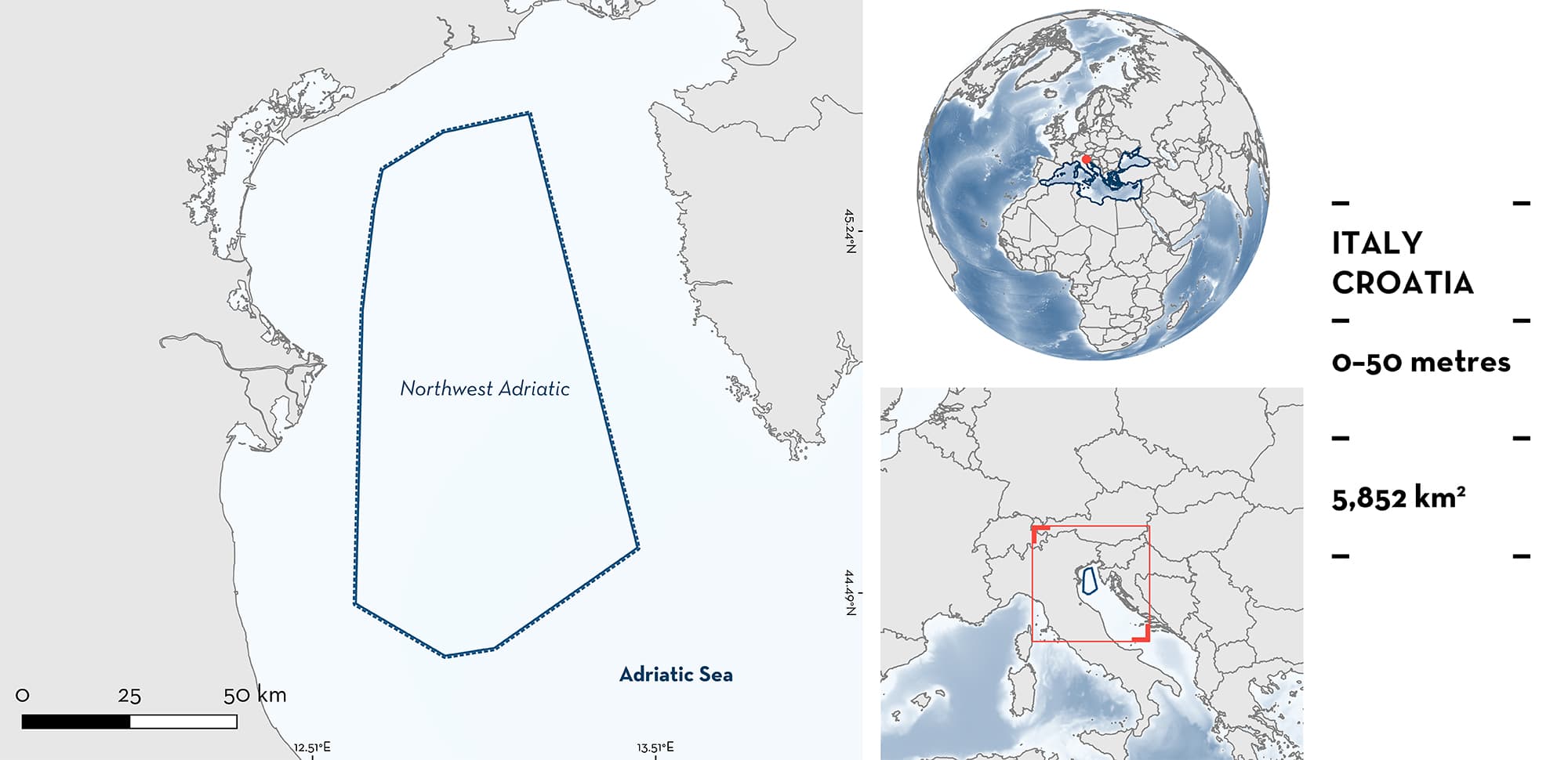ISRA FACTSHEETS
ISRA FACTSHEETS
MEDITERRANEAN AND BLACK SEAS REGION
Northwest Adriatic
Summary
Northwest Adriatic is located in the western part of the North Adriatic Sea basin. The area is characterised by shallow waters and is under the strong influence of the Po River plume which results in high marine productivity. The area includes mobile sandy substrates, seagrass meadows, hard substrate associations, and unique rocky outcrops. This area overlaps with the Northern Adriatic Ecologically or Biologically Significant Marine Area. Within this area there are: threatened species (e.g., Spiny Dogfish Squalus acanthias) and reproductive areas (e.g., Common Smoothhound Mustelus mustelus).
Download factsheet
Northwest Adriatic
DESCRIPTION OF HABITAT
Northwest Adriatic is located in the western part of the North Adriatic Sea basin. It is characterised by shallow waters, with an average depth of 35 m. The strong influence of the Po River plume results in low salinity, low water temperature, and high productivity (Fonda Umani 1996; Marini et al. 2008; Lipizer et al. 2014). The area has been recognised as a region of high marine productivity at several trophic levels from phytoplankton to fishes (Fonda Umani 1996).
The area includes a diversity of benthic and pelagic habitats (CBD 2023) including mobile sandy substrates, seagrass meadows, rocky outcrops, and open waters. These outcrops play an important ecological role because they are the only hard substrates in the area offering shelter and reproductive sites for several fish and invertebrate species (Casellato et al. 2007).
This area overlaps with the Northern Adriatic Ecologically or Biologically Significant Marine Area (CBD 2023).
This Important Shark and Ray Area is benthopelagic and ranges from surface waters (0 m) to a depth of 50 m based on the depths at which the Qualifying Species occur and the bathymetry of the area.
CRITERION A
VULNERABILITY
Two Qualifying Species considered threatened with extinction according to the IUCN Red List of Threatened SpeciesTM regularly occur in the area. These are the Endangered Common Smoothhound (Jabado et al. 2021) and the Vulnerable Spiny Dogfish (Finucci et al. 2020).
CRITERION C
SUB-CRITERION C1 – REPRODUCTIVE AREAS
Northwest Adriatic is an important reproductive area for two shark species. Dogfishes (Squalus spp.) and smoothhounds (Mustelus spp.) have generally dominated shark bycatch in the northern Adriatic Sea (Barausse et al. 2014; Bonanomi et al. 2018). Between 2006 and 2015, a total of 12,585 hauls from pelagic trawl fisheries were recorded in 3,160 monitored fishing trips in the northern Adriatic. In these hauls, 2,169 Spiny Dogfish and 833 Common Smoothhounds were captured (Bonanomi et al. 2018).
Between April and June across the study period (2006–2015), relatively small individuals (~90 cm total length [TL]) of Common Smoothhound were mostly caught at an average depth of 15 m (± 36 m SD) (Bonanomi et al. 2018). Reported size-at-birth for this species is 24–45 cm TL (Saïdi et al. 2008). Based on catches from a variety of fishing gear, pregnant females and juveniles of this species are found in the northern Adriatic (Bonanomi et al. 2018; Riginella et al. 2020).
Between July and September across the study period (2006–2015), small individuals (~70 cm TL) of Spiny Dogfish were incidentally captured at an average depth of 30 m (± 55 m SD). These were sometimes caught as aggregations of 5 to 146 individuals (Bonanomi et al. 2018). Reported size-at-birth for this species is 18–33 cm TL (Ebert et al. 2021).
Using data from these monitored fishing trips, this area was delineated by the spatial identification of aggregations of immature individuals using the following methods (Bonanomi et al. 2018). ‘Nursery areas’ were identified where large bycatch events of immature individuals were recorded (Bonanomi et al. 2018; note that the use of the term ‘nursery areas’ in the study does not match other ecological uses of the term [e.g., Heupel et al. 2007]). For both Common Smoothhound and Spiny Dogfish, size-at-maturity was the threshold to identify immature individuals. Thus, only bycatch events for each haul with at least 50% immature individuals caught were selected. Following this, aggregations with >18 individual Common Smoothhound and >8 individual Spiny Dogfish were selected, since these thresholds represented the 95th quantile of the distribution of catches of immature individuals. For both species, the minimal area containing the selected events was computed and considered as a potential ‘nursery area’ (Bonanomi et al. 2018). Aggregations of immature individuals for both species in this area resulted in a greater mean catch-per-unit-effort (CPUE) compared with other areas of the northern Adriatic Sea.
Download factsheet
SUBMIT A REQUEST
ISRA SPATIAL LAYER REQUEST
To make a request to download the ISRA Layer in either a GIS compatible Shapefile (.shp) or Google Earth compatible Keyhole Markup Language Zipped file (.kmz) please complete the following form. We will review your request and send the download details to you. We will endeavor to send you the requested files as soon as we can. However, please note that this is not an automated process, and before requests are responded to, they undergo internal review and authorization. As such, requests normally take 5–10 working days to process.
Should you have questions about the data or process, please do not hesitate to contact us.


